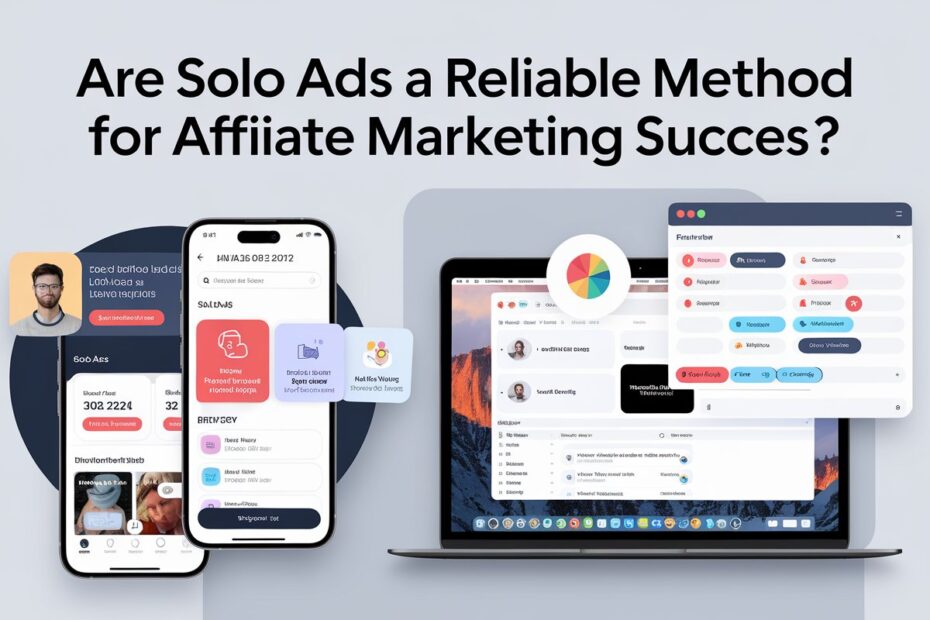Affiliate marketing is a popular and profitable business model, but the success of any affiliate campaign often hinges on the effectiveness of its promotional methods. One strategy that has gained attention in recent years is solo ads. But are they a reliable method for achieving affiliate marketing success? This article dives deep into the concept of solo ads, their advantages, disadvantages, and best practices to help you decide if they are the right fit for your affiliate marketing efforts.
Table of Contents
What Are Solo Ads?
Solo ads are a form of email marketing where advertisers pay vendors with large email lists to send promotional emails. These emails are typically tailored to promote a specific product, service, or affiliate offer. The main goal is to drive traffic to a landing page or affiliate link, where potential customers can convert.
How Solo Ads Work
- Vendor Selection: Choose a solo ad vendor with a mailing list relevant to your niche.
- Ad Creation: Craft a compelling email with a clear call-to-action (CTA).
- Target Audience: Ensure the vendor targets an audience that aligns with your affiliate offer.
- Tracking and Optimization: Use tracking tools to measure click-through rates (CTR), conversions, and return on investment (ROI).
Advantages of Using Solo Ads in Affiliate Marketing
1. Quick Traffic Generation
Solo ad can drive traffic to your affiliate offer almost immediately after the campaign is launched, making them a fast way to test new products or offers.
2. Targeted Reach
Reputable solo ad vendors often segment their email lists by niche, allowing you to target a specific audience likely to be interested in your offer.
3. Ease of Use
You don’t need extensive marketing skills to run a solo ad campaign. Vendors handle the email delivery, while you focus on crafting a compelling message.
4. Scalability
You can start small and scale up your campaigns based on initial results, minimizing upfront risks.
Disadvantages of Solo Ads
1. High Costs
Solo ad can be expensive, with prices often ranging from $0.30 to $1 per click. Without proper ROI tracking, you risk losing money on campaigns.
2. Quality of Traffic
Not all solo ad vendors provide high-quality leads. Some may have outdated or unresponsive email lists, resulting in low conversions.
3. Lack of Relationship Building
Unlike organic methods like content marketing or social media, solo ads do not help you build a long-term relationship with your audience.
4. Risk of Fraudulent Vendors
The industry has its share of fraudulent vendors who inflate click counts or provide bots instead of genuine leads.
Best Practices for Success with Solo Ads
1. Choose Reputable Vendors
Research and vet solo ad providers thoroughly. Look for reviews, testimonials, and case studies that demonstrate their credibility.
2. Focus on Niche Relevance
Ensure the vendor’s audience aligns with your target market to maximize conversions.
3. Craft Compelling Emails
Write a clear and engaging email with a strong call-to-action. Test subject lines, headers, and CTAs to optimize performance.
4. Use Tracking Tools
Implement tracking links to measure key metrics like CTR, conversions, and ROI. Tools like ClickMagick and Google Analytics are invaluable.
5. Start Small
Test campaigns with smaller budgets before committing to larger investments. Use the data to refine your strategy.
6. Combine with Other Strategies
To mitigate risks, integrate solo ad with other marketing methods like SEO, content marketing, and social media advertising.
Are Solo Ads Reliable for Affiliate Marketing?
The reliability of solo ads largely depends on your approach. If you choose trustworthy vendors, target the right audience, and measure your campaigns effectively, solo ad can generate significant traffic and conversions. However, their success is not guaranteed and may vary based on factors such as niche, product appeal, and ad quality.
For affiliate marketers looking for quick results, solo ad can be a valuable tool when used strategically. However, relying solely on them may not be sustainable in the long term. A diversified marketing strategy is often the best path to affiliate marketing success.
Conclusion
Solo ads can be a reliable method for affiliate marketing success if approached with caution and expertise. By understanding their pros and cons and implementing best practices, you can leverage solo ads to boost traffic and conversions. However, remember to diversify your promotional methods to build a robust and sustainable affiliate marketing business.
FAQs
1. What is the typical cost of solo ads?
Solo ads generally cost between $0.30 and $1 per click, depending on the vendor and audience niche.
2. How do I find a trustworthy solo ad vendor?
Research online reviews, ask for recommendations in affiliate marketing forums, and look for vendors with proven track records in your niche.
3. Can solo ads guarantee conversions?
No, solo ads cannot guarantee conversions. Their effectiveness depends on factors like audience targeting, ad copy, and product relevance.
4. Are solo ads suitable for beginners?
Yes, solo ads can be beginner-friendly since they don’t require extensive technical skills. However, beginners should start with small budgets to minimize risks.
5. What niches work best with solo ads?
Solo ads tend to perform well in niches like make money online (MMO), health and wellness, and self-improvement, where audiences are actively looking for solutions.
